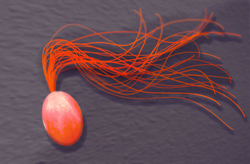| Thermococci | |
|---|---|
 | |
| Thermococcus gammatolerans | |
| Scientific classification | |
| Domain: | Archaea |
| Kingdom: | Methanobacteriati |
| Phylum: | Methanobacteriota |
| Class: | Thermococci Zillig and Reysenbach 2002 [1] |
| Orders [1] [2] | |
| Synonyms | |
| |


Thermococci is a class of microbes within the Euryarchaeota. [2]
Contents
They live in extremely hot environments, such as hydrothermal vents, [3] and their optimal growth temperatures tend to be around 75 to 85 °C. [4] Thermococcus and Pyrococcus (literally "balls of fire") are both obligately anaerobic chemoorganotrophs.
Thermococcus prefers 70–95 °C and Pyrococcus 70-100 °C. Palaeococcus helgesonii , recently discovered in the Tyrrhenian Sea, is an aerobic chemoheterotrophic that grows at temperatures of 45–85 °C with an optimal temperature of 80 °C. Thermococcus gammatolerans sp. nov. was recently discovered in the Guaymas Basin, and it grows at temperatures from 55 to 95 °C with an optimal temperature around 88 °C with an optimal pH of 6. It has pronounced radioresistance and can survive gamma radiation at 30 kGy. [5]
Thermococcus grows on organic substrates where there is a higher capacity of elemental sulfur. This archaeon mostly grows between temperatures 60–100 degrees Celsius. The average temperature where they thrive is around 85 degrees Celsius.
The DNA structure has a circular genome with around 2,353 coding sequence, and 2,306 are identified.